
Carlina is a genus of flowering plants in the family Asteraceae. It is distributed from Madeira and the Canary Islands across Europe and northern Africa to Siberia and northwestern China.

Vallisneria is a genus of freshwater aquatic plant, commonly called eelgrass, tape grass or vallis. The genus is widely distributed in tropical and subtropical regions of Asia, Africa, Europe, and North America.

Triadenum, known as marsh St. John's worts, is a small genus of flowering plants in the family Hypericaceae. The genus is characterized by opposite, blunt-tipped leaves and pink flowers with 9 stamens. They are distributed in North America and eastern Asia.

Pandanaceae is a family of flowering plants native to the tropics and subtropics of the Old World, from West Africa through the Pacific. It contains 982 known species in five genera, of which the type genus, Pandanus, is the most important, with species like Pandanus amaryllifolius and karuka being important sources of food. It is an ancient family dating from the early to mid-Cretaceous. This is a family that is not-well studied.

Geum aleppicum, commonly called yellow avens or common avens is a flowering plant native to most of the temperate Northern Hemisphere, from eastern Europe across Asia and North America.

Ulmus lanceifoliaRoxburgh, ex Wall., occasionally known as the Vietnam elm, is a very large tree endemic to a wide area of southern Asia. Its range extends southeast and eastwards from Darjeeling in the Himalaya, through Bangladesh, southern China, Myanmar, Thailand, Laos, Vietnam and on discontinuously into Indonesia, straddling the Equator in Sumatra and Celebes.

Aletris, the colicroot, colicweed, crow corn, or unicorn root, is a genus of flowering plants in the family Nartheciaceae, native to North America and to eastern and southeastern Asia, especially China. It was used as a component in Lydia Pinkham's original Vegetable Compound.

Ephedra sinica is a species of Ephedra native to Mongolia, Russia, and northeastern China.

Elymus is a genus of perennial plants with approximately 150 species in the grass family, related to rye, wheat, and other widely grown cereal grains.

Butomus is the only known genus in the plant family Butomaceae, native to Europe and Asia. It is considered invasive in some parts of the United States.
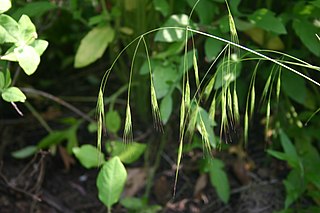
Schizachne is a genus of Eurasian and North American plants in the grass family. The only accepted species is Schizachne purpurascens, commonly called false melic. Three subspecies are recognized:

Najas marina is a species of aquatic plant known by the common names spiny water nymph, spiny naiad and holly-leaved naiad. It is an extremely widespread species, reported across Europe, Asia, Africa, Australia, the Americas and many oceanic islands. It can be found in many types of freshwater and brackish aquatic habitat, including bodies of alkaline water.
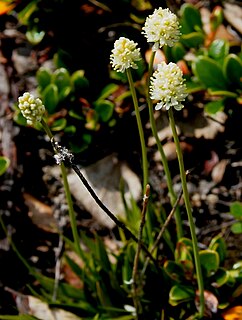
Tofieldia is a small genus of flowering plants described as a genus in 1778. It is widespread across much of Europe, Asia, and North America.
Calyciphora albodactylus is a moth of the family Pterophoridae. It is found in most of Europe, except Portugal, the Benelux, Great Britain and Ireland. It is also known from Russia and Anatolia. The species was first described by Johan Christian Fabricius in 1794.
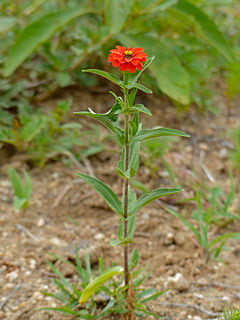
Zinnia peruviana, the Peruvian zinnia, is an annual flowering plant in the family Asteraceae. It is native to North America and South America.

Najas gracillima, the slender waternymph, is a submerged species of aquatic plant in the Hydrocharitaceae family. found in lakes and streams. It is native to China, Russian Far East, Japan, Korea, Taiwan, Iran, Alberta, Ontario, Newfoundland, Nova Scotia, New Brunswick, the eastern United States. It is also considered introduced and naturalized in France, Spain, Italy and California.
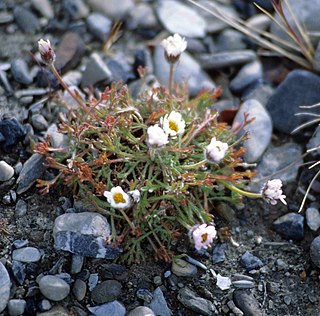
Arctanthemum integrifolium, the entire-leaved daisy, is a subarctic species of plant in the sunflower family. It grows in Alaska, northern Canada, Peary Land in northern Greenland, and the East Chukotka region of eastern Russia.
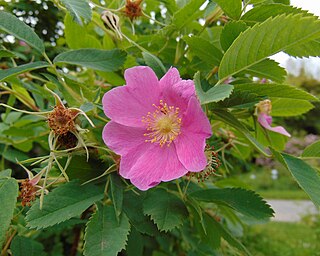
Rosa webbiana, occasionally called Webb's rose, wild rose, or thorny rose, is a widely distributed species of flowering plant in the family Rosaceae. It is native to Central Asia, Tibet and Xinjiang in China, Afghanistan, Pakistan, the western Himalayas, and Nepal. It grows in scrub, grassy places, valleys, and slopes. A diploid, its chromosome count is 2n = 2x = 14.
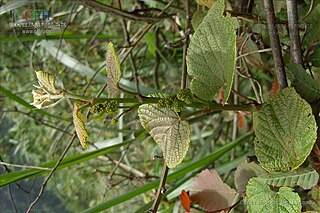
Vitis wilsoniae is a vining plant in the grape family native to China. It is commonly known as the net veined grape or reticulated grape. This species can be found in the provinces of Anhui, Chongqing, Fujian, Gansu, Guizhou, Henan, Hubei, Hunan, Shaanxi, Sichuan, Yunnan, and Zhejiang. The plant grows at altitudes of 400-2000m.

Vitis bellula, commonly known as the beautiful grape or small leaf hair grape, is a Chinese liana in the grape family. It is native to the provinces of Guangdong, Guangxi, Hubei, Hunan, and Sichuan. The plant grows at altitudes of 400–1,600 m (1,300–5,200 ft) and bears medium-sized purplish-black grapes.






















